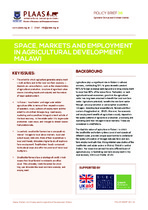| dc.contributor.author | Chirwa, Ephraim | |
| dc.contributor.author | Matita, Mirriam | |
| dc.date.accessioned | 2019-02-26T08:56:54Z | |
| dc.date.available | 2019-02-26T08:56:54Z | |
| dc.date.issued | 2015 | |
| dc.identifier.citation | Chirwa, E. et al. (2015). Space, markets and employment in agricultural development: Malawi. Policy Brief 36, Bellville: Institute for Poverty, Land and Agrarian Studies, University of the Western Cape | en_US |
| dc.identifier.uri | http://hdl.handle.net/10566/4291 | |
| dc.description.abstract | Agriculture plays a significant role in Malawi’s national
economy, contributing 35% to gross domestic product,
90% to foreign exchange earnings and providing employment
to more than 80% of the labour force. Particularly in such
agricultural-based economies, growth in the agricultural
sector has long been assumed to benefit the rural non-farm
sector. Agriculture potentially benefits the non-farm sector
through various production or consumption expenditure
‘linkages’, including local expenditure by farmers and their
workers (Haggblade et al., 2010). However, the economic
and employment benefits of agriculture crucially depend on
the spatial patterns of agricultural production, processing and
marketing (and their linkages to local markets). These are
considered in what follows. | en_US |
| dc.language.iso | en | en_US |
| dc.publisher | Institute for Poverty, Land and Agrarian Studies, University of the Western Cape | en_US |
| dc.relation.ispartofseries | Policy Brief;36 | |
| dc.subject | Markets | en_US |
| dc.subject | Employment | en_US |
| dc.subject | Agricultural development | en_US |
| dc.subject | Malawi | en_US |
| dc.subject | National economy | en_US |
| dc.title | Space, markets and employment in agricultural development: Malawi | en_US |
| dc.type | Other | en_US |

